Gigabyte GA-P35T-DQ6: DDR3 comes a knocking, again
by Gary Key on May 30, 2007 2:00 AM EST- Posted in
- Motherboards
Gaming Performance
As usual, gaming performance was tested with a variety of current games. We ran benchmarks with our standard 1280x1024 resolution with all games set to High Quality mode. Given the number of users that run 19" LCDs these days, 1280x1024 represents one of the most commonly used resolutions. We will provide final CrossFire numbers in our P35 roundup.
Battlefield 2
This benchmark is performed using DICE's built-in demo playback functionality with additional capture capabilities designed in-house. When using the built-in demo playback features of BF2, frames rendered during the loading screen are counted in the benchmark. In order to get a real idea of performance, we use the instantaneous frame time and frames per second data generated from our benchmark run. We discard the data collected during the loading screen and calculate a result that represents actual game play. While DICE maintains that results over 100fps aren't always reliable, our methods have allowed us to get useful data from high performing systems.
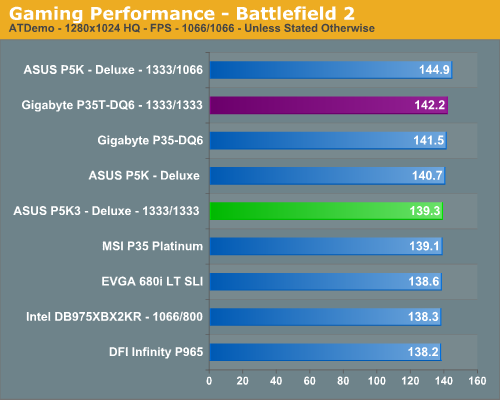
Serious Sam 2
This benchmark is performed using Croteam's built-in demo capability in the Serious Sam 2 engine. We utilize the included Branchester Demo and capture the playback results using the Ctrl-~ function. The benchmark features a large number of combatants, explosions, and general mayhem. The benchmark is can be CPU bandwidth or GPU sensitive depending upon the settings and resolution. We typically find this game is very playable at average in-game frame rates of 55 and above. We maximize all settings except antialiasing and anisotropic filtering within the general and advanced video settings.
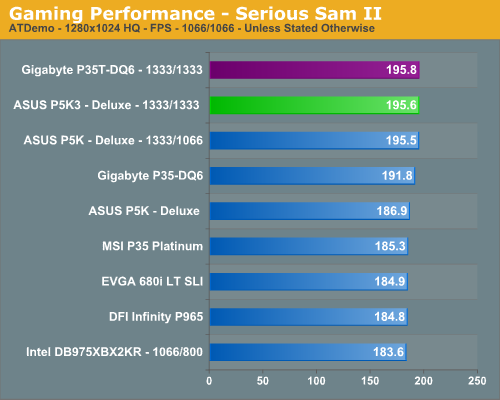
Company of Heroes
Company of Heroes was released last year and is still proving to be a very addictive RTS game around the office. The game is extremely GPU intensive and also requires a hefty CPU at times. The game contains a built-in performance test that utilizes the game engine to generate several different action scenes. We found the performance test gives a good indication of how well your system will perform throughout the game on average. We have found some of the in-game action sequences to be more demanding than the performance test and are working on game play benchmark that is repeatable. We generally found the game to be enjoyable with an average frame rate above 35fps.
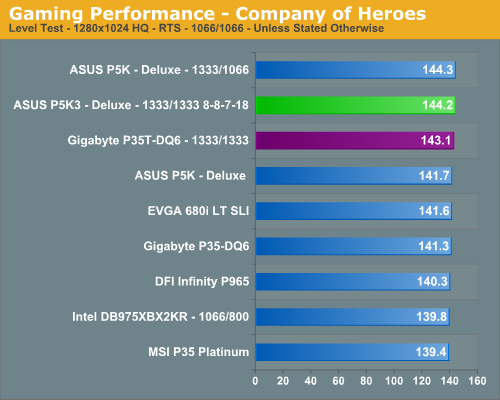
Prey
Prey offers some superb action sequences, unique weapons and characters, and is a visually stunning game at times. It still requires a very good GPU to run it with all of the eye candy turned on. We set all graphic settings to their maximum except for AA/AF and utilize a custom timedemo that takes place during one of the more action oriented sequences. We generally found the game to be enjoyable with an average frame rate above 35fps.
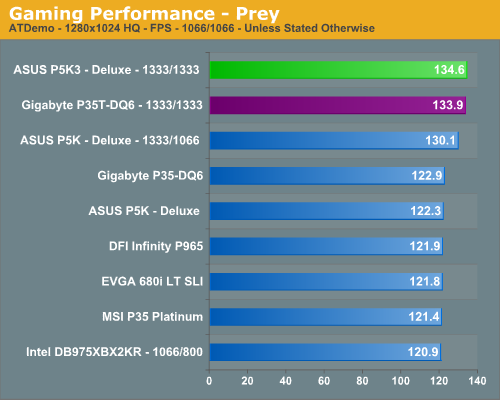
S.T.A.L.K.E.R.
S.T.A.L.K.E.R. is one of the favorite first person shooter games around the office as it continues to provide a great deal of replay value and the graphics are very good once the eye candy is turned on. What we especially like about the game is the atmosphere and the fact that it makes for a great system benchmark.
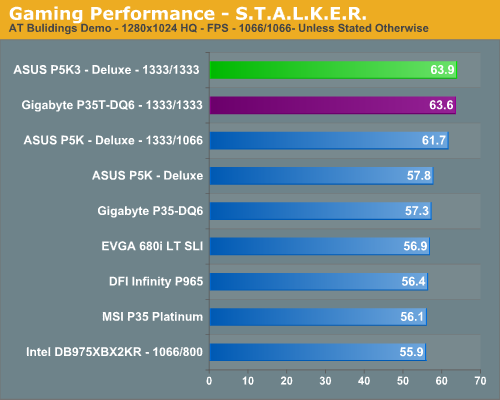
Gaming Summary
We see the ASUS DDR3 board struggling slightly in the Battlefield 2 test while the Gigabyte DDR3 offers very good performance. The improved memory latencies and bandwidth of the Gigabyte DDR3 board makes the difference over the ASUS DDR3 system in this benchmark that is both CPU and memory sensitive. Our Serious Sam 2 benchmark is CPU/memory sensitive and the increased bandwidth offered by the 1333FSB boards allows them to shine with the Gigabyte DDR3 board on top.
Our P35 DDR3 boards lead the pack in Prey and S.T.A.L.K.E.R. as both games are memory bandwidth sensitive. In our Company of Heroes test, the two DDR3 boards are once again at the top but trail our ASUS P5K DDR2 board operating at 1333FSB. Gaming continues to be driven by the GPU, especially in the latest titles, but every extra bit of performance always helps.
As usual, gaming performance was tested with a variety of current games. We ran benchmarks with our standard 1280x1024 resolution with all games set to High Quality mode. Given the number of users that run 19" LCDs these days, 1280x1024 represents one of the most commonly used resolutions. We will provide final CrossFire numbers in our P35 roundup.
Battlefield 2
This benchmark is performed using DICE's built-in demo playback functionality with additional capture capabilities designed in-house. When using the built-in demo playback features of BF2, frames rendered during the loading screen are counted in the benchmark. In order to get a real idea of performance, we use the instantaneous frame time and frames per second data generated from our benchmark run. We discard the data collected during the loading screen and calculate a result that represents actual game play. While DICE maintains that results over 100fps aren't always reliable, our methods have allowed us to get useful data from high performing systems.

Serious Sam 2
This benchmark is performed using Croteam's built-in demo capability in the Serious Sam 2 engine. We utilize the included Branchester Demo and capture the playback results using the Ctrl-~ function. The benchmark features a large number of combatants, explosions, and general mayhem. The benchmark is can be CPU bandwidth or GPU sensitive depending upon the settings and resolution. We typically find this game is very playable at average in-game frame rates of 55 and above. We maximize all settings except antialiasing and anisotropic filtering within the general and advanced video settings.

Company of Heroes
Company of Heroes was released last year and is still proving to be a very addictive RTS game around the office. The game is extremely GPU intensive and also requires a hefty CPU at times. The game contains a built-in performance test that utilizes the game engine to generate several different action scenes. We found the performance test gives a good indication of how well your system will perform throughout the game on average. We have found some of the in-game action sequences to be more demanding than the performance test and are working on game play benchmark that is repeatable. We generally found the game to be enjoyable with an average frame rate above 35fps.

Prey
Prey offers some superb action sequences, unique weapons and characters, and is a visually stunning game at times. It still requires a very good GPU to run it with all of the eye candy turned on. We set all graphic settings to their maximum except for AA/AF and utilize a custom timedemo that takes place during one of the more action oriented sequences. We generally found the game to be enjoyable with an average frame rate above 35fps.

S.T.A.L.K.E.R.
S.T.A.L.K.E.R. is one of the favorite first person shooter games around the office as it continues to provide a great deal of replay value and the graphics are very good once the eye candy is turned on. What we especially like about the game is the atmosphere and the fact that it makes for a great system benchmark.

Gaming Summary
We see the ASUS DDR3 board struggling slightly in the Battlefield 2 test while the Gigabyte DDR3 offers very good performance. The improved memory latencies and bandwidth of the Gigabyte DDR3 board makes the difference over the ASUS DDR3 system in this benchmark that is both CPU and memory sensitive. Our Serious Sam 2 benchmark is CPU/memory sensitive and the increased bandwidth offered by the 1333FSB boards allows them to shine with the Gigabyte DDR3 board on top.
Our P35 DDR3 boards lead the pack in Prey and S.T.A.L.K.E.R. as both games are memory bandwidth sensitive. In our Company of Heroes test, the two DDR3 boards are once again at the top but trail our ASUS P5K DDR2 board operating at 1333FSB. Gaming continues to be driven by the GPU, especially in the latest titles, but every extra bit of performance always helps.










22 Comments
View All Comments
SirJoe - Saturday, June 2, 2007 - link
this is cool for you computer buffsGooger - Saturday, June 2, 2007 - link
I just did a google search for XMS3 and the only merchant to have it in stock at the bargain price of $599 is Tiger Direct! Yikes, I think I will wait a while untill the price of DDR3 becomes competitive with DDR2.AdamK47 - Wednesday, May 30, 2007 - link
Sorry Gigabyte, I just can't see myself ever buying a board with pink memory slots. Shoulda stuck with the blue.Stele - Friday, June 1, 2007 - link
"Pink it's my new obsessionPink it's not even a question..."
:D Sorry, couldn't resist the temptation :P
yacoub - Wednesday, May 30, 2007 - link
Thank you especially for the note about larger heatsinks being very difficult to mount and the associated image of the back of the motherboard so folks can see what they face if they have a heatsink that requires connecting a backing plate (as most of the larger ones do).yyrkoon - Wednesday, May 30, 2007 - link
What annoys me, is that every Gigabyte motherbord review has this same 'annoyance' written in. Come now fellas, you can only say it about 500 times, beore it starts getting old, and how hard is it really to press two keys in combination ? Gigabyte obviously is doing this for a reason, and if it takes me writting this comment to point that out, well, I just dont know . . .
Saying something like: 'You will need to press cntl + F1 to access the 'protected' portion of the BIOS . . .' Would sounds less critical, would not come off as negativity, and would keep you guys from sounding lazy . . .
TA152H - Wednesday, May 30, 2007 - link
It's not hitting the keys that is the problem, it's remembering to do it. When you have loads of computers with motherboards, it's nice if they have a standard way to access features, instead of adding an inane key sequence like CTRL-F1. It is annoying, because four years down the road if you have to work on this motherboard, for whatever reason, you have to try to remember this bizarre and otherwise trivial detail. Standards are nice, especially when following them doesn't involve a tradeoff.yyrkoon - Thursday, May 31, 2007 - link
Yeah, well I personally have a bad memory, but after reading countless Gigabyte motherboard reviews from AT here, I do not think I will ever forget this key combination.Anyhow, this is one reason why when given the chance I always opt for ABIT boards, while other may opt for Asus, Gigabyte, whatever. Once you become used to a given OEM BIOS Layout, it is hard to make a change in OEMs without suffering a bit in the knowledge department(at least temporarily).
*yyrkoon hugs his NF-M2 nView . . .
TA152H - Saturday, June 2, 2007 - link
Keep in mind, not everyone buying a motherboard from Gigabyte is going to be reading these articles, and proper journalism dictates they don't depend on people knowing every previous article, so they appropriately bring it up. Before you remark what's the point in them mentioning it for people that don't read it, it's certainly going to be read by Gigabyte and by complaining enough times, they may take notice.I agree that it is often best to just buy from one maker, or limit the number. Unfortunately, I'm an idiot and I end up with stuff from too many makers. I try to buy only Intel and Supermicro, but they are too expensive sometimes, so I've ended up buying a lot of Taiwanese junk before finally finding a company from there I have had success with (don't ask me why, but Epox seems to work best for me). So, I've got all this Asus, Soyo, Aopen, MSI, Gigabyte, Tyan and a few I don't even remember running and it's difficult to deal with all the different BIOS settings when they get cute and try to be different. On the plus side, these motherboards tend to break pretty regularly so I have less and less of the inferior brands. Well, except for Epox. I have no idea why these things never break on me, but I have a feeling it's just random luck :P .
Frumious1 - Wednesday, May 30, 2007 - link
I won't forget, but I'm still annoyed by this, just like I'm annoyed by a BIOS that moves certain features into odd areas. I hate that there are about 20 ways to manage memory timings, voltages, bus speeds, etc. (and that's just picking either an AMD or an Intel platform). What's really stupid about Gigabyte's method of hiding settings is that it's not even all of the settings that get hidden. The major area lately that doesn't show up is memory timings. You can tweak voltages and fry your RAM, but GOD FORBID you play with memory timings! (There are some other things that get hidden as well, but I don't recall exactly what. I base this off my DS3 system.)